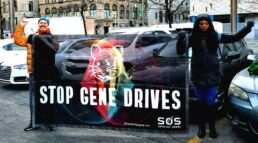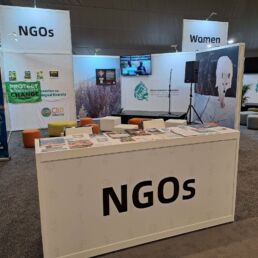What happened to Gene Drives at COP15 of the UN Convention on Biodiversity?
In December 2022, States from all around the world gathered in snowy Montreal to discuss the future of biodiversity protection and conservation until 2030. What did they have to say about new technologies such as gene drives?
The Post-2020 Biodiversity Framework (GBF) has been often referred as a ‘breakthrough’ to halt biodiversity loss. However, the discussions and decisions made in Montreal left synthetic biology watchdogs, like the Stop Gene Drives Campaign, with a bitter aftertaste of corporate influence.
Biotechnology giants such as Brazil and Argentina strongly negotiated to remove any mentions to the precautionary principle and risk assessment from all texts. There was also persistence in inserting the dogma of ‘innovation’ wherever possible. After five Open Ended Working Groups over the course of three years and two weeks of COP15 discussions, the world is left with a Target 17 on Biotechnology that does not do anything beyond reiterating the CBD Convention of 1992. One clear sign that the world of biotechnology has evolved since 1992 is that some of the negotiators sitting at the table today were born in that year. Unfortunately, the new Post-2020 Biodiversity Framework does not seem to keep up with it.
In good time, not all was gloom in Montreal. In addition to adopting the GBF, COP15 managed to set up a new multidisciplinary Ad-Hoc Technical Expert Group for horizon scanning, monitoring and technology assessment of synthetic biology. “Expertise from a broad range of scientific disciplines, as well as interdisciplinary and intercultural expertise, indigenous peoples and local communities” will be included in the process.
Another constructive aspect of the decision is that the conflict of interest resolution from the COP14 will apply, aiming to ensure the scientific integrity and independence of the work of expert groups. It builds on harmful past experiences revealed in the Gene Drives Files (= documents obtained under the US freedom of information provisions showing that the Bill and Melinda Gates Foundation financed an agribusiness public affairs firm to covertly skew an expert process under the CBD in order to lobby against the regulation of GDOs). This is an attempt to confine so called ‘independent’ scientist acting on behalf of philanthropists and billionaires in CBD expert groups.
When it comes to the particular issue of gene drives, the most relevant decision was taken at the meeting of the Parties to the Cartagena Protocol (CP-MOP 10). This Protocol manages biosafety matters. Gene Drives present new uncharted challenges in comparison to ‘classic’ Genetically Modified Organisms covered by the Protocol. Accordingly, an Ad-Hoc Technical Expert Group was established in Montreal to develop additional guidance materials on risk assessment and management of gene drive organisms. Important to note: without the ‘m’ of multidisciplinary.
The focus area of this group will be gene drive mosquitoes, as for them gene drives have been furthest developed to date. These guidance materials will be of voluntary nature, but will help to inform risk assessment globally and, hopefully, unveil open questions, concerns and challenges regarding impacts of gene drives on the environment.
What lies ahead?
The next one to two years are decisive for the (multidisciplinary) technical expert groups scanning biotechnologies like gene drives and working on guidance materials. In the meantime, governments and their institutions, Indigenous Peoples and Local communities, and civil society organizations can submit information to be considered by the expert groups. These actors can also directly participate in online forums to raise their concerns and open questions on synthetic biology and gene drives.
At the next COP (16) in Turkey, States will discuss whether the process of horizon scanning and technology assessment should be continued. They will as well present the indicators that will help to measure the progress of reaching Target 17. We are curious to see how the ‘successful’ attainment of that Target will be measured and for what sorts of projects governments will be eligible for funding.
In short, this means two broad possibilities. On the one hand, the UN CBD could continue requesting risk assessment of new technologies such as gene drives in order to be able to measure all their impacts on biodiversity. On the other hand, the process can be cut short and no risk assessment would be guaranteed.
Finally, when it comes to gene drives under the Cartagena Protocol we hope that the process will genuinely work towards better equipping national governments for risk assessment of gene drives.
At the Stop Gene Drives campaign, we believe that a thorough and holistic risk assessment of gene drives will further expose that current levels of scientific understanding are not sufficient to predict their (irreversible) potential impacts. This would bring yet more clarity on why the release of gene drives into the environment is incompatible with the objectives of the Convention and its Protocols.
Further COP related posts/articles by the Stop Gene Drive Campaign:
ECO articles during the COP15:
01.12.2022 Gene drives are the opposite of nature conservation
05.12.2022 Ecuador’s Galápagos Islands are not a laboratory for testing risky gene drive organisms
07.12.2022 All CBD watchdogs should guard against synthetic biology threats to biodiversity
10.12.2022 Brazilian intransigence on biotech is a violation of human rights
18.12.2022 Snowman to snow-mess: negotiations at COP15 are opening doors to risky technologies
Blogpost leading up to the Conference:



